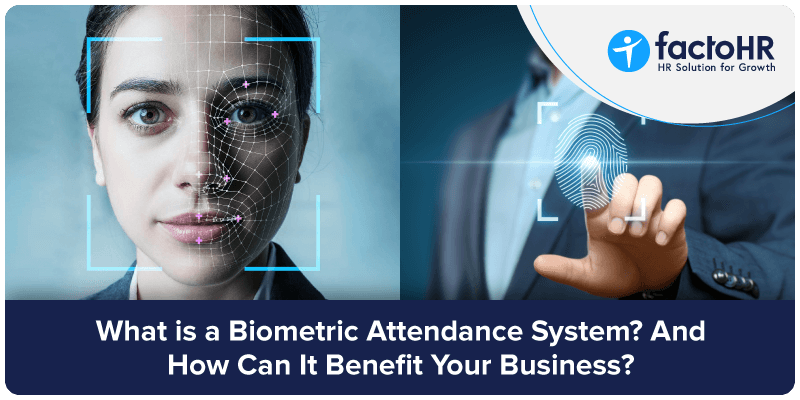What is a Biometric Attendance System? Benefits & Features

Table of Contents
Think of a workplace where attendance fraud and manual errors are common. Also, all the document recordings add to a lot of paperwork and compliance. Many organizations faced these attendance system errors. Traditional systems had issues like proxy punches and inaccurate attendance data recording. For this reason, businesses today are shifting from traditional attendance systems like punch cards to biometric attendance systems.
As organizations increasingly adopt digital tools to simplify their attendance, a biometric system stands out as a reliable approach for workforce management. This article will discuss the key benefits and features of a biometric attendance system.

What is a Biometric Attendance System?
A Biometric Attendance System makes use of unique biological traits to track and record employees’ attendance. Fingerprints, facial recognition, voice recognition, and iris scans are common biometric identifications. This way, it is safe to record attendance as it is an alternative to paper-based or traditional attendance recording. Employees or students can register their biometric data in the system and use it when they punch in or out. The system then compares the scanned data with the stored information and verifies the identity of the person.
The system records employees’ time of arrival and departure, with which attendance reports can be generated. These reports help calculate payroll and overtime. A biometric attendance machine is used to record the accurate time in and out of employees. This saves time and increases the efficiency of an organization. A biometric attendance system can record attendance of multiple employees at different times of the day or shifts. To address these fundamental shortcomings, the Biometric Attendance System was implemented.
A biometric system records the data only if the data is stored for that particular identity, and reduces the chance of proxy attendance. If someone wants to proxy for another employee, they can’t because their biometric information won’t match. A biometric attendance machine is one of the most widely used technologies in the workplace.

How does a Biometric Attendance System Work?
A biometric attendance system tracks employees’ attendance using fingerprints or facial recognition. When an organization sets up the system, employees’ biometric data is scanned. The information is stored in the database and compared with the previously recorded data.
If there is a match, then the employee attendance is marked present. One of the advantages here is that it reduces the chances of a buddy punch (employee’s friends or colleagues punching on behalf of them) or proxy attendance. This system is used frequently by almost all modern organizations. It reduces the chances of human errors and the paperwork needed to track attendance. These are the main benefits of employing a biometric attendance machine. Some of the other benefits are:
Data Capture
Data capture in the biometric attendance management system captures fingerprints or facial features by applying specialized equipment such as cameras or fingerprint scanners, then transforms the data into a digital format for storage and comparison.
Verification
The biometric attendance machine works by capturing a biometric sample (e.g., fingerprint or facial recognition) and comparing it with the stored template. The access is then confirmed or denied based on the match.

Key Features of a Biometric Attendance System
The biometric attendance system has various benefits for any organization. Here are the key features that every organization must consider to ease the attendance process.
Biometric Identification
The Biometric Attendance system uses various identification types to calculate employee working time and attendance. It uses fingerprint scanning for accurate identification and employee attendance. It also removes the use of IDs and timecards, as this traditional method has the possibility of unauthorized access on work premises. Biometric identification simplifies employees’ time in/out and helps in payroll processing. The system also eliminates the chance of buddy or proxy punching. Some of the other features of using a biometric attendance system are:
- Eliminate incorrect billing
- Manage paid and sick leave
- Manage workforce statistics for permanent and contractual employees
In recent trends, all businesses have adopted biometric identification to ease HR operations.
Mobile App Support
Workers using mobile applications with built-in biometric attendance functions can authenticate their attendance using facial recognition and GPS tracking. The system provides three primary capabilities: real-time monitoring, offline functionality, and HR system integration. The mobile app supports both workforce operational performance and protects valuable data.
Auto-Generated Reports & Analytics
The manual generation of reports seems very time-consuming for HR professionals when analyzing any operations. The system generates automated HR reports and analytics to identify attendance trends and patterns. These reports help understand each employee’s work hours and absenteeism rate. The reports and analytics can be customized according to an organization’s needs and help make informed decisions. Here, the reports can be generated for details related to employees’ working hours and late arrivals.
Customized Rules and Policies
Biometric attendance systems enable companies to make specialized rules regarding shift work hours, including rules for late arrivals and leaves. The systems enhance security measures and productivity standards through streamlined human resources management and payroll functions. Companies adopting biometric solutions lead to improved attendance tracking, surpassing manual attendance systems.
Leave & Shift Management
In BAS, workers can submit time off requests, which managers can approve or reject according to company rules. This helps reduce documentation needs and eliminates errors in payroll processing. The shift management process in BAS generates employee roster schedules and manages staff shifts to sustain proper workforce numbers.

Types of Biometrics Used to Record Employees’ Attendance
There are many kinds of biometrics used in attendance systems. Below mentioned are the three most used biometric types:
Fingerprint Attendance Machine
A fingerprint attendance machine records employees’ attendance through the unique patterns in the prints of their fingers. This is one of the most common ways an employee’s attendance can be marked present. When the fingertip patterns match the data stored in the system, the employee is officially on premises or at work. As the fingerprints are different for every human being, the chances of duplicate recording or errors are almost minimized. This makes the system more accurate for attendance marking. This is mainly used to record employees’ attendance at the workplace and for students at college.
Face Scanner Attendance System
In facial recognition, characteristics, like the distance between the eyes and the shape of the cheekbones, are measured. This creates a faceprint in each employee’s scanner. With these key facial features, the system matched the images already stored in the database. This is a form of biometric authentication. This feature is used in access control for security purposes and by mobile phone manufacturers to unlock phones.
Iris and Voice-Based Systems
Some other types of biometrics used to record employees’ attendance are iris- and voice-based systems. Iris recognition is a visually distinct pattern, i.e., it has unique patterns in a person’s iris. This coloured part of the eye records the identity of an employee while marking attendance. This is a highly accurate and reliable method for recording employee presence.
Voice-based systems work by recognizing an employee’s voice. This technology can identify a user by their voice. This is because the human voice is a unique feature; each person has a different frequency pattern in their voice.

Key Benefits of a Biometric Attendance System
Eliminates Proxy Attendance & Theft
Biometric attendance systems record the presence of an enrolled employee only. If an employee’s colleague or friend tries to punch on behalf of the employee, attendance will not be marked. This is because the system has recorded fingerprints or facial recognition to identify the employee.
Time theft is one of the most common challenges employers face today. This costs organizations more for the times when the employee was not working. To avoid time theft, biometric systems are an excellent choice for accurate presence marking.
Enhances Accuracy
Biometric attendance systems achieve higher precision through the usage of distinctive authentication methods, such as fingerprints and face recognition techniques. Due to the advancement of technology and the availability of smart sensors, no employee can fake their attendance. This is why many modern organizations prefer to use a biometric attendance system and avoid the cost to the company. The time in and out is recorded accurately, making the system more reliable. The reliability of these records enables better compensation systems for managers within the organization.
Increase Security
A biometric system is highly safe, as no one can steal employees’ data from the database. Proxy attendance can also be prevented, as only the enrolled employee’s attendance is marked present. The employees who are a part of the organization will be allowed access to the premises. In traditional attendance methods, individuals use passwords and pins for unauthorized access. This control access can be used for physical locations, like buildings, and digital systems for data.
Automated Attendance Tracking
Biometric attendance systems automatically track attendance in real time. They calculate employees’ working hours to provide accurate results. The automated attendance tracking seamlessly supports HR functions. The system reduces administrative workload and enhances HR professionals’ ability to get attendance reports instantly.
Boosts Productivity
Implementing biometric attendance systems automatically improves workplace productivity because of their time-tracking capabilities. The system automates attendance recording and helps HR professionals spend less time on manual data entry. It also provides real-time access to data, which helps managers make decisions about changing shifts or staffing levels.
Cost-Effective Solution
Using Biometric systems eliminates the need for passwords for security purposes and related costs. Strong biometric attendance prevents security breaches and makes the system more reliable for organizations. Accurate attendance leads to simplified payroll and overtime processes. This will also improve employees’ experience through accurate payroll.
Remote and Cloud-Based Accessibility
Cloud-based biometric systems help manage and monitor access control from a remote location. This way, temporary grants and permissions can be granted without being physically present. Remote and cloud-based accessibility also simplifies operations by providing real-time updates with centralized data storage.
Proper Payroll Records
This system keeps an accurate record of employee attendance and working hours. The records are supported in the payroll process by generating their total working hours. This reduces the chances of time theft and risks. Payroll processing becomes more simplified, saving HR professionals’ time and resources. These systems can integrate with payroll software, which leads to real-time data synchronization and accurate calculations.

Conclusion
Implementing biometric attendance systems in an organization is essential to accurately recording employees’ attendance. The system boosts the overall efficiency of both employees and HR professionals by reducing manual attendance entry. It automatically records employees’ time in/out and reduces the chance of errors.
Organizations obtain higher productivity from this innovative technology because employees are paid for the time they have worked, and companies are paying for the work only. It provides accuracy and security through an easy-to-use system. Modern businesses implement hybrid work arrangements because they offer cloud-based solutions at economical costs. Thus, any modern organization can achieve more efficiency and productivity by applying a biometric attendance system.
Are Biometric Systems Safe?
Biometric systems operate safely by implementing unique bodily traits that prevent access from unauthorized individuals.
What Issues do Biometric Attendance Systems Present to Users?
Implementing and maintaining biometric attendance systems requires high costs, and users face privacy concerns and worry about system failure.
Can Biometric Attendance be Conducted on Mobile Devices?
Implementing optimized apps allows businesses to perform biometric attendance on mobile devices, which supports convenient remote work logging.
Grow your business with factoHR today
Focus on the significant decision-making tasks, transfer all your common repetitive HR tasks to factoHR and see the things falling into their place.

© 2025 Copyright factoHR


